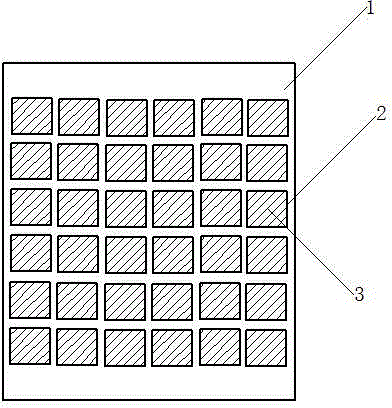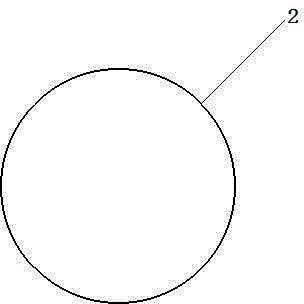Patch
A plaster and sticking technology, which is applied in the field of traditional Chinese medicine and medicinal products, can solve the problems of baking and aging of plaster, difficulty in adapting, and complicated softening methods, etc.
- Summary
- Abstract
- Description
- Claims
- Application Information
AI Technical Summary
Problems solved by technology
Method used
Image
Examples
specific Embodiment 1
[0020] Such as figure 1 As shown, the present invention provides a plaster, the surface of which is a rectangular carrier layer 1 made of elastic adhesive plaster. On the inner surface of the carrier layer 1, several small pieces of backing layer blocks 2 made of polypropylene spun-bonded non-woven fabric are attached. The side of the mounting layer 2 in contact with the carrier layer 1 is coated with glue, so that the mounting layer block 2 can be attached to the carrier layer 1 . The other side of the mounting layer block 2 is smeared with a plaster layer 3 of one deck of colloidal viscous ointment. The medicinal ingredients in the ointment layer 3 are selected according to the actual condition.
[0021] The area of the mounting layer block 2 should not be too large. It is best when the mounting layer block 2 is a square shape with a width of 5mm. This size will not cause inconvenience in applying ointment because the size is too small, and it will not be too large. And...
specific Embodiment 2
[0024] Such as figure 2 As shown, as an improvement to the aforementioned plaster, the mounting layer block 2 is circular. The corners of the square plaster are easy to warp after using for a period of time, which will cause the whole plaster to wrinkle. The mounting layer block 2 is designed as a circle, because the circle has no corners, thereby effectively avoiding the wrinkling of the whole plaster due to the warping of the corners after use for a period of time, which affects the efficacy of the medicine.
[0025] As an improvement to the aforementioned plaster, the plaster also includes a protective layer. The protective layer has the same shape as the carrier layer 1, and is also made of elastic adhesive plaster. When not in use, the protective layer is attached to the ointment layer 3 to protect the ointment. When using, first tear off the protective layer, and stick the plaster on the diseased part.
specific Embodiment 3
[0026] Such as image 3 As shown, as another improvement to the aforementioned plaster, the plaster also includes a cup body 4, the carrier layer 1 surrounds the cup body 4, and the outer surface is in close contact with the outer surface of the side wall of the cup body 4. When the ointment layer 3 is a black plaster, the black ointment layer 3 can be softened by adding hot water into the cup body 4 before use, and the entire carrier layer 1 can be used after softening. When the cup body 4 is made of paper, the black plaster ointment layer 3 can be softened by putting boiling water on the water dispenser for 3-4 minutes, which is very convenient for people in modern fast-paced life.
[0027] As another improvement, the cup body 4 is conical. The tapered cup body 4 is very convenient for a plurality of plasters to be connected in series, which saves space and is convenient for packaging during sales.
PUM
 Login to View More
Login to View More Abstract
Description
Claims
Application Information
 Login to View More
Login to View More - R&D
- Intellectual Property
- Life Sciences
- Materials
- Tech Scout
- Unparalleled Data Quality
- Higher Quality Content
- 60% Fewer Hallucinations
Browse by: Latest US Patents, China's latest patents, Technical Efficacy Thesaurus, Application Domain, Technology Topic, Popular Technical Reports.
© 2025 PatSnap. All rights reserved.Legal|Privacy policy|Modern Slavery Act Transparency Statement|Sitemap|About US| Contact US: help@patsnap.com



